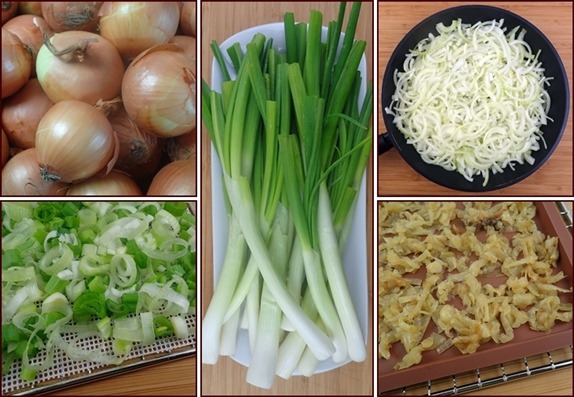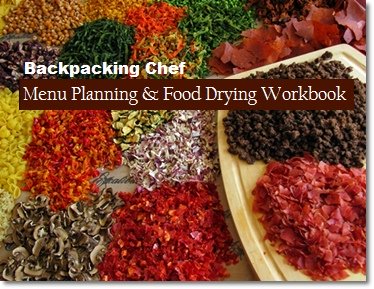Dehydrating
Onions
Ready to stink up the house? Dehydrating onions is right up there with tuna for smelliness while drying, and you might even start crying. Brush those tears aside, campers, because a pinch of dehydrated onions, while lighter than a chickadee’s feather, will make your backpacking meals a pleasure.
I include dehydrated onions in backpacking recipes like Kickin’ Veggie Mac & Cheese. The onions are part of a medley of dried vegetables including tomatoes, bell peppers, and mushrooms.
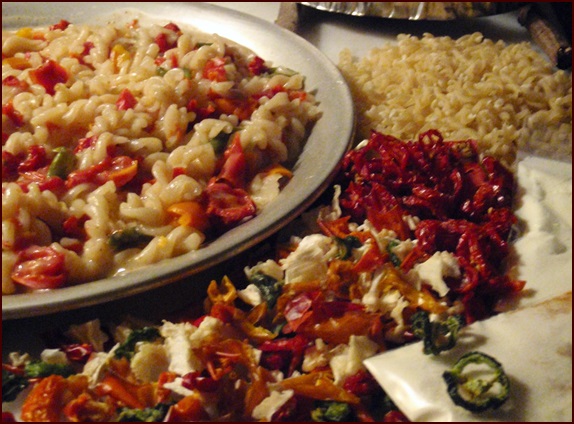
Photo: Kickin’ Veggie Mac & Cheese with a pinch of dehydrated onions. Grab the recipe.
Can you dry onions without stinking up the house?
Try moving the dehydrator to a small room with a window, such as a laundry room, and blow the onion-air out with a fan. Some folks dehydrate onions on the back porch, but if it’s humid outside, that will slow down the drying process, not to mention you may attract a wayward possum or raccoon—they love the smell of dehydrating onions.
What I often do is dry onions in a mixed-dehydrator load with tomatoes, bell peppers, and mushrooms—maybe even with trays of tomato sauce. Then the house smells more like a pizza parlor than an onion warehouse.
How to Dehydrate Onions
Dehydrating
Onions Raw
Any type or size onion may be dehydrated. Large onions are well-suited to dicing. White or yellow onions add a light color to dehydrated meals, while red onions add purple.
Dehydrating onions raw is fast and easy. Simply peel
onions, cut into ½-inch
slices (1 cm), and then turn the slices 90° and slice them the same width. Pull
any layers that are sticking together apart. The final shapes will be irregular due to the roundness of onions.
Tip to reduce watery eyes:
Cut both ends off onion, peel, and drop onion into a bowl of cool water. Repeat until all the onions are peeled.
Wash the cutting board before dicing the onions, since the first cuts may have been in contact with dirt or mold.
Remove one onion at a time, give it a quick rinse, pat dry, and dice or slice.
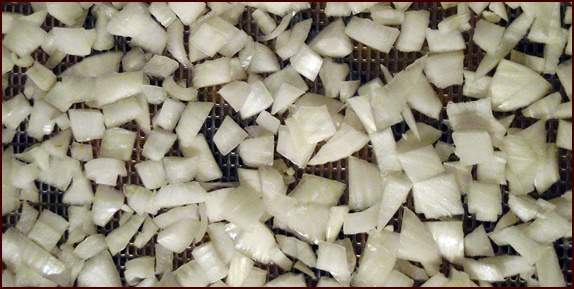
Photo: Diced onions before dehydrating.
Place diced onions on top of a mesh dehydrator sheet in a single layer. It’s ok to crowd onions a bit because they shrink a lot while drying.
Dehydrate onions at 135°F (57°C) for 8+ hours. Dehydration times can be longer depending on room humidity, amount of food in the dehydrator, and dehydrator model used.
Dehydrating onions at 125°F (52°C) also works, but that will increase the drying time by several hours… producing more of that lovely onion scent to mingle with your curtains.
Dried raw onions will be slightly pliable. No moisture should be present when you tear a piece in half.
Storing Dehydrated Onions
For shelf life up to a year, store dehydrated onions in an airtight container such as a canning jar. Enclose an oxygen absorber or vacuum seal the jar with a jar sealing accessory. Store away from light and heat. Color should hold well. If oxygen is in the container, onions will turn brown over time due to oxidation, and they will be less attractive when added to meals.
Check the container after a few days to make sure no moisture has formed on the glass. If you see any, put the onions back in the dehydrator for another hour or two.
Dehydrating
Caramelized Onions
Dehydrated caramelized onions takes backpacking meals and soups to a higher level of deliciousness. You get a sweet and savory flavor that dried raw onions can’t match.
The price of delicious is one hour of cooking. I cook the onions slow and low without oil. By not cooking them in oil, they dry crispy, and last longer in storage.
Caramelizing Onions without Oil
Ingredients:
- 500 g white or yellow onions (1 lb. +)
- 1 tsp. salt
- 2 tsp. sugar
- 3 tsp. apple cider vinegar
- ¼ cup water (60 ml)
Cookware
Use a nonstick pan with a lid that heats evenly, or a ceramic slow-cooker pot. A wooden spatula works well for stirring.
Note: Onions cook down quite a bit. If you have a large pan, you can double the ingredients.
Cut the Onions
Cut off ends of onions and peel. Cut onions in half longwise. With cut-side down, cut onion halves crosswise, into half-slices about ⅛” to ¼” thick (½ cm). Separate the rings as you drop them in a nonstick frying pan.
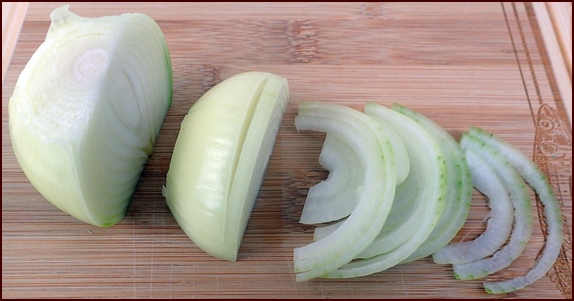
Photo: Onions cut for caramelizing, but they can also be dried raw in this shape.
Cook the Onions
Total cook time is 1 hour.
Stir 1 teaspoon of salt into onions in pan. Turn stove on to medium-low. (#4 on a dial that goes up to 9).
Place lid on pan. Not much will happen for the first 15 minutes. The onions will start to steam and soften.

Photo: Caramelizing onions at 1 minute, 30 minutes, and 60 minutes.
After 15 minutes, give the onions a stir every 5 minutes, replacing the lid after each stir. The onions will start to dry out, and they will stick to the pan a little. Add a tablespoon of water as needed to keep the onions from burning.
At 30 minutes, stir in the sugar. Leave the lid off the pan now, and stir onions more frequently. Add water a tablespoon at a time to keep the onions from burning. You will use about ¼-cup of water total.
At 50 minutes, stir in 2 teaspoons of apple cider vinegar. Scrape any sticky onion parts off the pan.
At 55 minutes, stir in 1 more teaspoon of vinegar. Continue stirring and scraping for a few more minutes. The onions will be caramelized with some browning.
Test for deliciousness. You’re going to love them.
Dehydrate the Onions
Spread cooked onions on a nonstick dehydrator sheet in a single layer. It’s ok if they are a little crowded at first because the onions shrink. However, overcrowding will increase drying time.
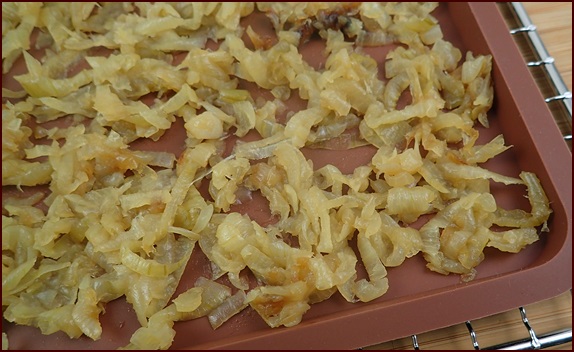
Photo: Caramelized onions on silicone nonstick tray before drying.
Dehydrate caramelized onions at 135°F (57°C) for 9+ hours. Stir the onions halfway through the drying process if possible.
Caramelized onions will be almost crispy when dry, but slightly pliable. They will not be sticky once they are completely dry.
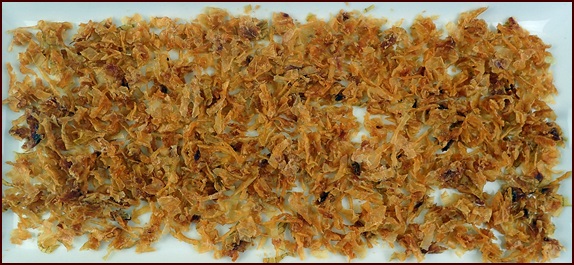
Photo: Dehydrated caramelized onions.
Store dried onions in an airtight container such as a mason jar with an oxygen absorber. Check for moisture inside jar after a few days, and return onions to dehydrator if necessary.
Yield: 500 grams of onions (after cutting, but before cooking) will yield 60 grams of dehydrated caramelized onions, about 1 cup.
How to Use Dehydrated Caramelized Onions
For home use, dried caramelized onions are far tastier and healthier in a green bean casserole than those French Fried Onions in a can—and just as crispy. They are also great on top of any salad.
For backpackers who make cold-soak salads, dried caramelized onions are wonderful when stirred in right before eating, and they make a great addition inside tuna tortilla wraps.
Make caramelized onions a main component of any pasta meal along with a protein source such as ground beef or beans.
Add dried caramelized onions to any soup to bump up the savory component. They swim well with mushrooms that were seasoned with soy sauce or Worcestershire sauce before drying.
Dehydrating
Green Onions
Last but not least in onion category is the green onion, also known as the scallion or spring onion. I can’t think of a single backpacking meal or soup that couldn’t benefit from a pinch of dried green onions.
Green onions taste milder than big bulbous onions, and the green stems contain bonus nutrients for your good health. Best of all, they’re fast and easy to dehydrate.
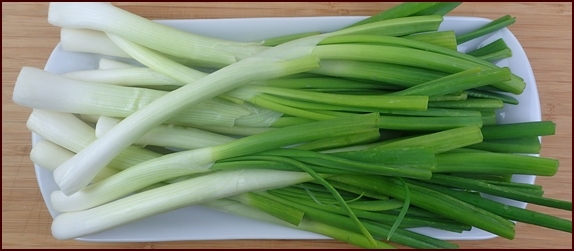
How to Cut Green Onions
Begin by cutting off the stringy root ends and snip off any wilted or dried out parts of the green stems. Wash and pat dry.
Slice crosswise about ¼-inch thick (½ cm). If you want to get fancy, you can cut at an angle.
Separate the layers by pushing on the centers of the slices with a finger. It won’t make a big difference if you don’t get them all separated; they shrink and separate more while drying.
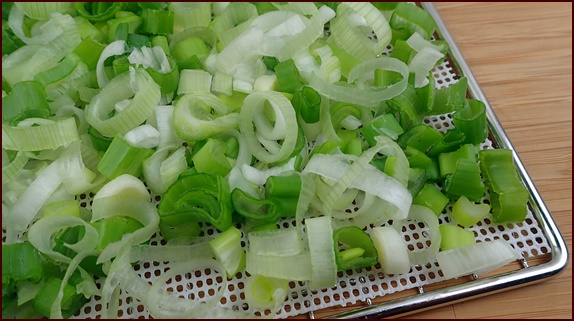
Photo: Sliced green onions on silicone mesh dehydrator sheet before drying in a Cosori dehydrator.
How to Dehydrate Green Onions
Mix the white and green parts together so they are evenly distributed.
Place on a nonstick, mesh dehydrator sheet. Using a mesh sheet improves air circulation around the onions and reduces the drying time.
Dehydrate green onions at 135°F (57°C) for 5+ hours. When dry, green onions will be brittle.
Store in an airtight jar. You may end up keeping a container of dehydrated green onions near your other dried herbs in the kitchen. That way you can add a pinch whenever you make an omelet or soup.
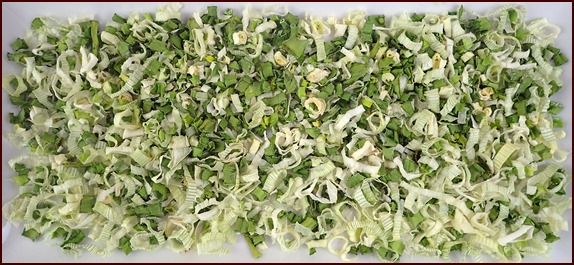
Photo: Dehydrated green onions.
Products
Used on this Page (Amazon):
COSORI Dehydrator Digital Controls, 6 Stainless Steel Trays
Mesh Dehydrator Sheets, Silicone, 14” x 14”, 12-Pack
Homey Dehydrator Sheets, Teflon, 14” x 14”, 10-pack
Silicone Dehydrator Trays with Raised Edges, 11.8" x 10.8", 6-Pack
Vacuum Sealer Kit for Wide & Regular-Mouth Mason Jars
As an Amazon Associate, Backpacking Chef earns from qualifying purchases. Thank you!
Explore More…
Dehydrating Vegetables | Fruit | Meat
Share this page with friends on social media.
Free E-book & Newsletter
Free with Trail Bytes subscription.
Dehydrating Food from A–Z

